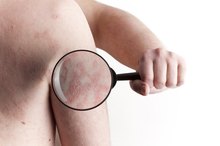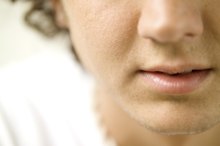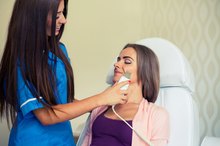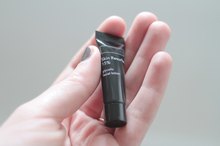How to Use Retin-A 0.05
Retin-A, the brand name for the generic drug tretinoin, is a topical anti-acne medication dispensed in gel, cream or liquid form, in concentrations ranging from 0.025 to 0.1 percent. Retin-A 0.05 percent is a medium-strength formulation only available in cream form 2. According to dermatologist Andrea L. Zaenglein, professor of dermatology at the Pennsylvania State School of Medicine, Retin-A is a potent skin irritant, so it’s important to use all forms of Retin-A as directed. Unlike the gel and liquid preparations, Retin-A 0.05 percent cream is subject to “piling” or over-application, which increases the risk of irritation.
Apply Retin-A
Each night before bed, wash your hands and the affected area with mild, fragrance-free, unmedicated soap and water using a non-abrasive cloth.
How to Use Moisturizer With Retin-A
Learn More
Pat dry and wait 20 to 30 minutes.
Dispense a small amount of Retin-A 0.05 cream onto your clean fingertips. Ask your pharmacist or doctor how much you should use.
How to Use MetroGel for Acne
Learn More
Pat Retin-A 0.05 percent cream lightly onto the affected area. Do not reapply to areas you have already covered.
In the morning, repeat steps 1 and 2.
Apply sunscreen formulated for sensitive skin to the affected area. Sunscreen serves as a moisturizer and provides sun protection, since people who use Retin-A are more sensitive to sun.
Tips
If you cannot wait 20 to 30 minutes to allow your skin to dry completely, use a hair dryer set to cold or cool jet for a few minutes. If your hair dryer does not have this setting, do not use the hot or warm settings because these actually increase your risk of irritation.
Warnings
While you are using Retin-A, avoid topical products that contain alcohol, menthol, spices, lime, benzoyl peroxide, salicylic acid, sulfur or resorcinol. Especially during the first few weeks or months of treatment with Retin-A, these products may increase your risk of irritation.
- Each night before bed, wash your hands and the affected area with mild, fragrance-free, unmedicated soap and water using a non-abrasive cloth.
- Pat Retin-A 0.05 percent cream lightly onto the affected area.
Related Articles
References
- "Fitzpatrick's Dermatology in General Medicine, 7th Edition"; F. Wolff et al.; 2008
- Retin-A: Prescribing Information
- MedlinePlus. Tretinoin topical. Updated March 15, 2019.
- Dando TM, Wellington K. Topical tazarotene: a review of its use in the treatment of plaque psoriasis. Am J Clin Dermatol. 2005;6(4):255-72. doi:10.2165/00128071-200506040-00006
- Russell JJ. Topical therapy for acne. Am Fam Physician. 2000;61(2):357-66.
- Berger R, Rizer R, Barba A, et al. Tretinoin gel microspheres 0.04% versus 0.1% in adolescents and adults with mild to moderate acne vulgaris: a 12-week, multicenter, randomized, double-blind, parallel-group, phase IV trial. Clin Ther. 2007;29(6):1086-97. doi:10.1016/j.clinthera.2007.06.021
- Drugs.com. Retin-A. Updated June 1, 2018.
- Drugs.com. Retin-A Micro. Updated October 1, 2019.
- Drugs.com. Renova. Updated September 2, 2019.
- Kircik LH. Microsphere technology: Hype or help? J Clin Aesthet Dermatol. 2011 May;4(5):27-31.
- Kircik LH. Evaluating tretinoin formulations in the treatment of acne. Journal of Drugs in Dermatology. 2014 Apr;13(4):466-70.
- MedlinePlus. Tretinoin topical. U.S. National Library of Medicine. Updated March 15, 2019.
- Valeant Pharmaceuticals International. Retin-A Micro prescribing information. Revised October 2017.
- Yeh L, Bonati LM, Silverberg NB. Topical retinoids for acne. Seminars in Cutaneous Medicine and Surgery. 2016 Jun;35(2):50-6. doi:10.12788/j.sder.2016.024
- Leyden J, Stein-gold L, Weiss J. Why Topical Retinoids Are Mainstay of Therapy for Acne. Dermatol Ther (Heidelb). 2017;7(3):293-304. doi:10.1007/s13555-017-0185-2
- U.S. Food & Drug Administration. Retin-A [labeling]. Updated June 10, 2002.
- Knor T. Flattening of atrophic acne scars by using tretinoin by iontophoresis. Acta Dermatovenerol Croat. 2004;12(2):84-91.
- Davis EC, Callender VD. Postinflammatory hyperpigmentation: a review of the epidemiology, clinical features, and treatment options in skin of color. J Clin Aesthet Dermatol. 2010;3(7):20-31.
- Mukherjee S, Date A, Patravale V, Korting HC, Roeder A, Weindl G. Retinoids in the treatment of skin aging: an overview of clinical efficacy and safety. Clin Interv Aging. 2006;1(4):327-48.
- U.S. Food & Drug Administration. RETIN-A MICRO® [labeling]. Revised January 2014.
- Chen K, White TJ, Juzba M, Chang E. Oral isotretinoin: an analysis of its utilization in a managed care organization. J Manag Care Pharm. 2002;8(4):272-7. doi:10.18553/jmcp.2002.8.4.272
- "Tretinoin Topical." MedlinePlus. 03 April 2000. U.S. National Library of Medicine & National Institutes of Health.
- Kircik LH. "Evaluating tretinoin formulations in the Treatment of Acne." Journal of Drugs in Dermatology. 2014 Apr;13(4):466-70.
- Yeh L, Bonati LM, Silverberg NB. "Topical Retinoids for Acne."Seminars in Cutaneous Medicine and Surgery. 2016 Jun;35(2):50-6.
- Zaenglein AL, Pathy AL, Schlosser BJ, Alikhan A, Baldwin HE, et. al. "Guidelines of Care for the Management of Acne Vulgaris." Journal of the American Academy of Dermatology 74.5 (2016): 945-73.
Writer Bio
Heather Gloria began writing professionally in 1990. Her work has appeared in several professional and peer-reviewed publications including "Nutrition in Clinical Practice." Gloria earned both a Bachelor of Science in food science and human nutrition from the University of Illinois. She also maintains the "registered dietitian" credential and her professional interests include therapeutic nutrition, preventive medicine and women's health.









